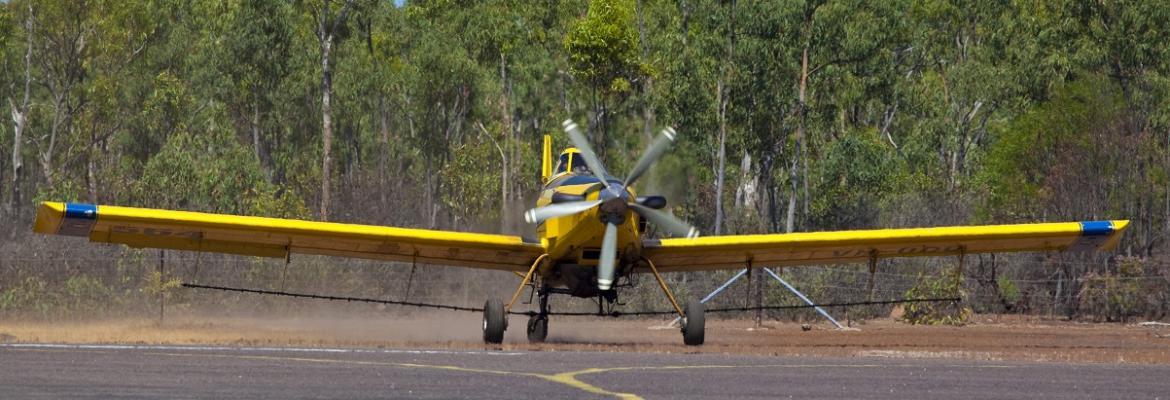
This fixed wing aerial dispersant capability is part of the National Plan for Maritime Environmental Emergencies. The capability was developed in conjunction with—and is jointly funded by—the Australian Institute of Petroleum (AIP) through its Geelong-based Australian Marine Oil Spill Centre (AMOSC).
Based on the concept of using large agricultural fixed wing aircraft to apply oil spill dispersants, the capability is designed to complement dispersant spraying arrangements using vessels which are typically confined to close inshore work.
Aircraft location
We maintain four aircraft strategically located to provide full coverage of the Australian coastline.
The aircraft are located in:
- Adelaide, South Australia
- Ballidu, Western Australia
- Batchelor, Northern Territory
- Scone, New South Wales
Aircraft types and capability
AMSA uses 802 air tractors to apply dispersant.
This aircraft is used throughout the world for oil dispersant operations in addition to agricultural and firefighting activities. All aircraft are turbine powered single engine and have the ability to carry up to 3600 litres of dispersant.
Aircraft features
When applying dispersant, aircraft may need to fly as low as 7-10 metres above the water. The air tractor aircraft are specifically designed to fly at such heights allowing the operations to be conducted safely and the dispersant applied accurately and effectively.
Features allowing the aircraft to do this include:
- Real time navigation equipment allowing the aircraft to fix position, in real time, relative to the ground or water.
- Continuous real time readout in latitude and longitude ensuring the pilot can at all times identify the position of the aircraft.
- Data logging system allowing the aircraft at all times to log and record its position whilst also recording the flight path of the aircraft.
Activation of aircraft
Aircraft are activated by AMSA upon notification of a ship sourced oil spill that threatens to cause pollution damage, particularly in sensitive areas. For offshore oil and gas incidents, aircraft are activated by AMOSC.
Each aircraft is available to fly with a maximum of four hours’ notice, twenty-four hours per day, seven days per week.
Airbase manager and loading crew
We will also activate an airbase manager who is responsible for the management and supervision of the aircraft whilst also overseeing the loading of dispersant into the aircraft. The loading crew may consist of up to two personnel who are responsible for loading dispersant into the aircraft in addition to assisting with aircraft refuelling operations.
Dispersant
Dispersant is stored in 1000 litre containers.
The dispersant is pumped into the aircraft using a pump and dry coupling brake which prevents any spillage when connecting or disconnecting the hose to the aircraft.
AMSA and AMOSC maintain stockpiles of dispersant strategically positioned throughout Australia. Stockpiles may consist of a variety of dispersant types. The type of dispersant stored within a specific area is generally determined by the level of risk and the type of oil products which transit through that particular area.
Upon activating the fixed wing aerial dispersant capability, AMSA or AMOSC will coordinate the transport of the dispersant and the dispersant loading equipment to the airfield where the aircraft will be based. We will establish an airbase at the nominated airfield and all dispersant aircraft will operate from this airfield during the oil spill response.
Air Attack Supervisor
Due to the height and speed the dispersant aircraft are required to fly at it is extremely difficult for the pilot alone to determine when to apply the dispersant.
To assist the pilot in applying the dispersant a separate aircraft with a trained air attack supervisor onboard is tasked to fly above the aircraft and direct the pilot towards the heaviest concentrations of oil.
The air attack supervisor will direct the pilot when to commence and cease spraying. The air attack supervisor will monitor the success of the dispersant operations and report back to incident management team.
Operational support
Aircraft undertaking dispersant operations may be supported by a number of response assets dependent on the operational requirements of the incident. This may include satellite aircraft tracking, surface vessels, fixed wing and rotary aircraft.
These assets are deployed to provide assistance to the dispersant aircraft should the aircraft encounter any difficulties during its operation.
More information
More information on the use of dispersants during oil spill response can be found at our pollution response section.
